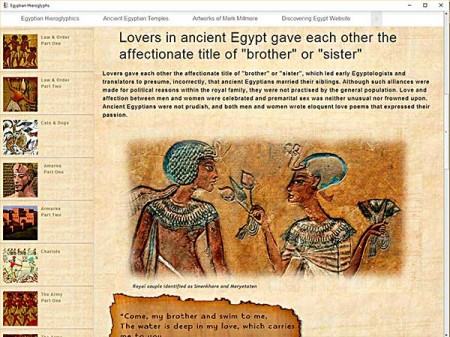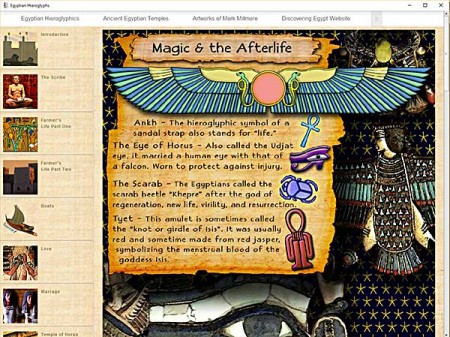Akhenaten the Heretic 1352–1336 BC


Amenhotep IV changed his name to Akhenaten and defied tradition by establishing a new religion that believed that there is but one god; the sun god Aten. By the time Akhenaten took the throne, his family had been ruling Egypt for nearly two hundred years and had established a huge empire dominating Palestine, Phoenicia, and Nubia.
A century before, Thutmose III had swept all before him, conquering the Middle East and Nubia and establishing a military priesthood which now controlled the empire. At the center was the god Amun of Thebes and his priests had become powerful. The imperial elegance of Egypt was supreme. It was rich and confident, with soldiers and officials established in foreign countries. Of course foreigners, in turn, came to live in Egypt, bringing new customs and ideas. The young prince and future king grew up in this new and changing Egypt.
At the beginning of his reign, the young pharaoh, Amenhotep IV, still worshiped the old gods, especially Amun of Thebes and the sun god, Re-Harakhte. However, within a few years there were changes. He abandoned work on a temple dedicated to Re-Harakhte and began to build a new temple to worship the sun god Aten.
The Aten was never shown in human or animal form, but represented as the sun disk with extended rays ending in hands. Aten was the life-giving and life-sustaining power of the sun. Unlike the old gods, he had no carved image hidden in a dark room deep within a temple, but was worshiped out in the light of day.

Queen Nefertiti, famous from her portrait bust, is thought to have been an Asian princess from Mitanni. She encouraged and supported her husband in his revolutionary ideas and together they took on the religious establishment. In the fifth year of his reign, the king changed his name from Amenhotep (“Amun is Pleased”) to Akhenaten, or “Servant of the Aten” thus formally declaring his new religion. He moved his capital from Thebes to a place now called Tell el-Amarna or Amarna, more than 200 miles (300 km) north, on a desert bay on the east side of the Nile River. Here he began to build a new city, which he called Akhetaten, “Horizon of Aten.”
The new city had many spacious villas with trees, pools, and gardens. Akhenaten encouraged artistic inventiveness and realism and the walls of the temples and houses were painted in an eccentric new style. Among the surviving works of this period are the colossal statues of Akhenaten, the paintings from his private residence, the bust of his wife Nefertiti, and that of his mother, Queen Tiy. These works are unique in Egyptian art, as they do not flatter the king and his family but reveal them as real people, in all their beauty and decay.
The religion of the Aten is not completely understood today. We do know that Akhenaten and his wife Nefertiti worshipped only the sun god, and the names of other gods and goddesses were removed from view. The funerary religion of Osiris was dropped, and Akhenaten became the source of blessings for people after death. But this religious and artistic renaissance was short lived; Akhenaten made himself unpopular by closing the old temples, and his lack of enthusiasm for the practical duties of kingship was detrimental to Egypt’s Imperial interests. Surviving documents show that Akhenaten paid little attention to the army and navy, foreign trade began to fall off, and internal taxes began to disappear into the pockets of local officials.
Letters to the king discovered in the ruins of Tell el-Amarna, known as the Amarna Letters, show the discontent of the army commanders and high commissioners in Palestine and Syria. The local princes, who had been loyal to Egypt, no longer saw any advantage in trading with Egypt. The Hittites from the north began to make gains and this led to a general disintegration of the empire. Eventually, dissatisfied priests and civil officials combined with the army to discredit the new religion. There is some evidence that at the urging of Tiy, the queen mother, Akhenaten made compromises to placate the different factions growing within Egyptian society. He also became estranged from Nefertiti.
When Akhenaten died, he was succeeded briefly by Smenkhkare, his favorite, and then by Tutankhaten who change his name to Tutankhamun, dropping the Aten and embracing Amun.
Tutankhamun eventually returned Egypt to its traditional values and Akhenaten’s memory was erased. Later Egyptian historians would refer to him only as “the heretic king.”
The city of Akhenaten was abandoned and the court returned to Thebes. Later Horemheb razed the city to the ground and Rameses II reused the stone blocks of its temples for his work at nearby Hermopolis.
Akhenaten was an intellectual and philosophical revolutionary who had the power and wealth to indulge his ideas. However, the ancient Egyptians were a deeply religious people who loved their ancient traditions and were not ready to embrace such radical changes. It would not be until the Christian era that the Egyptians would finally reject the old gods in favour of a single universal deity.
Melvyn Bragg and guests discuss the Pharaoh Akhenaten. Guests include Kate Spence, Richard Parkinson and Elizabeth Frood.
Ancient Egyptian Anecdotes
The Ancient Egyptians in their own words
Illustrated Papyri translations edited for the modern reader.







